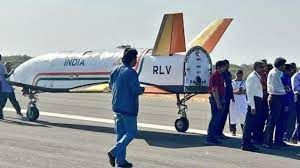UPSC Daily Current Affairs- 4th April 2023 | Current Affairs & Hindu Analysis: Daily, Weekly & Monthly PDF Download
GS-I
Basholi paintings
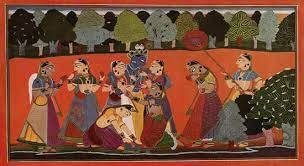
Why in News?
Recently, the world-famous Basohli Painting which is popular for its miniature art style from Kathua district of Jammu has obtained the Geographical Indication (GI) Tag.
About Basholi paintings:
- Basholi paintings originated in the Basholi region of Jammu and Kashmir.
- It is a reputed school of miniature paintings known for its vivid, evocative colours, bold lines, and deep-set facial patterns.
- It is considered the first school of Pahari paintings
- Patronage: The Basholi painting style flourished during the 17th and 18th centuries under the patronage of local rulers and wealthy merchants.
- Features of the Basholi painting
- It has peculiar characteristics, they have perfect geometrical patterns, bright colours and glossy enamel.
- Colours used: Ochre yellow, brown, and green grounds predominating.
- The figures in the paintings are shown clad in rich costumes, stylised faces and large bulging eyes lent unique individuality to these paintings.
- Themes: The portraits of local rulers, Radha-Krishna, and Madhava-Malati love themes and themes from the Bhagavata Purana.
- These are painted on paper, cloth, or wood using natural pigments and dyes.
What is a Geographical Indication Tag?
- A Geographical Indication is a sign used on products that have a specific geographical origin and possess qualities or a reputation that are due to that origin.
- Geographical indications are typically used for agricultural products, foodstuffs, wine and spirit drinks, handicrafts and industrial products.
- The Geographical Indications of Goods (Registration and Protection) Act, 1999 seeks to provide for the registration and better protection of geographical indications relating to goods in India.
- This GI tag is valid for a period of 10 years following which it can be renewed.
Source: The Hindu
Nevado del Ruiz Volcano
Why in News?
Recently, People living on the upper slopes of the Nevado del Ruiz volcano in Colombia are being evacuated after an increase in seismic activity.
About Nevado del Ruiz Volcano:
- Nevado del Ruiz is an ice-clad stratovolcano located in the Andes Mountains of Colombia, South America.
- It is part of the former Ruiz-Tolima volcanic complex as well as the dangerous Pacific Ring of fire.
- Previous eruption
- The volcano has erupted several times in the past, with the most catastrophic eruption occurring on November 13,
- Since the 1985 eruption, has remained active, with several smaller eruptions occurring in the years following the disaster.
What is a stratovolcano?
- Stratovolcano is also called a composite volcano.
- This volcanic landform is characterized by a conical shape formed by layers of volcanic material deposited during successive volcanic eruptions.
- These volcanoes tend to slope gently at the base but rise quickly near the summit to form tall mountain peaks.
- They are typically found above subduction zones, and they are often part of large volcanically active regions, such as the Ring of Fire that frames much of the Pacific Ocean.
Key facts about the Pacific Ring of fire:
- It also known as the Circum-Pacific Belt is a path along the Pacific Ocean characterized by active volcanoes and frequent earthquakes.
- Its length is approximately 40,000 kilometres (24,900 miles).
- It traces boundaries between several tectonic plates—including the Pacific, Juan de Fuca, Cocos, Indian-Australian, Nazca, North American, and Philippine Plates.
Source: BBC
GS-II
Finland to join NATO Military Alliance

Why in News?
NATO Secretary-General said that Finland will become the 31st member of the military alliance.
What is the North Atlantic Treaty?
- North Atlantic Treaty, often referred to as the Washington Treaty, states the parties to the treaty seek to promote stability and well-being in the North Atlantic area.
- The signatories affirm their faith in the purposes and principles of the UN Charter and express their desire to live in peace with all people and governments, the treaty states.
Establishment | April 4, 1949 |
Headquarters | Brussels, Belgium |
Membership | 30 member countries, including the United States, Canada, and most of Europe |
Objective | Collective defense against external aggression and the preservation of peace and security |
Article 5 | Collective defense clause which states that an attack on one member is an attack on all members |
Military Commanders | Supreme Allied Commander Europe (SACEUR) and Supreme Allied Commander Transformation (SACT) |
Main Decision-Making Body | North Atlantic Council (NAC) |
Funding | Contributions from member countries, based on a cost-sharing formula |
Partnerships | NATO has partnerships with several countries and international organizations, including Australia, Japan, South Korea, and the United Nations |
Criticisms | Criticized for its role in the Cold War and for its intervention in conflicts outside of Europe, such as the war in Afghanistan |
What is the process for securing NATO membership?
Process for Securing NATO Membership | Description |
| Establishment of consensus | Member countries establish consensus about a country’s potential membership. |
| Invitation to join Membership Action Plan (MAP) | Applicant countries may be invited to join MAP. This provides preparatory advice, assistance, and practical support tailored to their specific needs. It concludes with the formal timetable for the completion of prerequisite reforms. |
| Annual feedback report | NATO draws an annual report providing feedback to the aspirant country about its progress in their annual national programmes, and identifying areas for further action. |
| Confirmation of intent | NATO experts and representatives of the invited countries meet in Brussels to obtain formal confirmation of the invitee’s willingness and ability to meet the political, legal, and military obligations and commitments of NATO membership. |
| Issue of letter of intent | The applicant country issues a formal letter of intent to NATO, confirming the obligations and commitments of the organization. |
| Necessary amendments and ratification | The necessary amendments are made to make the invitee a party to the Washington Treaty, followed by ratification of the applicant country’s constitutional protocols for facilitating membership. |
| Acceding to the Treaty | Secretary-General calls the potential new members to accede to the North Atlantic Treaty. This is after all NATO members notify their acceptance to the government of the United States, the depository of the Washington Treaty, about the applicant. |
| Membership confirmed | Following the invitee depositing their instruments of accession with the US State Department, the applicant becomes a member of NATO. |
The MAP obligations
Chapter | Issues identified |
Political and Economic | Settle disputes peacefully, promote human rights and democracy, refrain from force, contribute to collective defence, establish civilian control of armed forces |
Defence | Improve military capabilities, participate in Partnership for Peace Programme, contribute to collective defence planning, ensure interoperability |
Resources | Allocate sufficient budget resources, contribute to NATO’s common-funded activities |
Security | Ensure security of sensitive information in adherence to NATO security policy |
Legal | Scrutinize domestic law for compatibility with NATO rules and regulations |
Current applicants and members
| Year | New Members |
Formation: 1949 | Belgium, Canada, Denmark, France, Iceland, Italy, Luxembourg, Netherlands, Norway, Portugal, UK, US |
| 1952 | Greece, Turkey |
| 1955 | West Germany |
| 1982 | Spain |
| 1999 | Czech Republic, Hungary, Poland |
| 2004 | Bulgaria, Estonia, Latvia, Lithuania, Romania, Slovakia, Slovenia |
| 2009 | Croatia, Albania |
| 2020 | North Macedonia |
Why does Russia fume over NATO?
- NATO’s expansion: Russia views NATO’s expansion into Eastern Europe as a threat to its security and influence in the region. The alliance’s decision to accept former Soviet republics and Warsaw Pact members as members is seen by Russia as a direct challenge to its strategic interests.
- Military exercises: Russia has also expressed concern over NATO military exercises in the region, which it sees as a provocation and a show of force. NATO’s decision to station troops and equipment in Eastern Europe has also been criticized by Russia.
- Missile defense system: Russia has been particularly critical of NATO’s missile defense system, which it sees as a threat to its own nuclear deterrence capabilities. Russia argues that the system is designed to neutralize its strategic weapons and that it undermines global strategic stability.
- Ukraine and Georgia: Russia has accused NATO of interfering in the affairs of Ukraine and Georgia, two former Soviet republics that are seeking closer ties with the West. Russia sees NATO’s support for these countries as an attempt to encircle and contain Russia.
Source: Indian Express
Summit for Democracy 2023
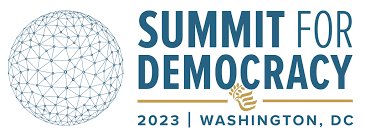
Why in News?
Recently, President Joe Biden announced the opening of his second Summit for Democracy.
About Summit for Democracy 2023:-
- It is hosted by the U.S. Agency for International Development (USAID).
- Objectives: to renew democracy at home and confront autocracies abroad.
- The Summit comprises a series of events and a Year of Action (YoA) led by the US Government to support democratic renewal around the world.
- The Summit for Democracy as a process is an extraordinary opportunity to galvanize attention and mobilize international action.
- This is the second Summit for Democracy, the U.S. Agency for International Development (USAID).
- It unveils new efforts to advance democracy abroad like:
- Presidential Initiative for Democratic Renewal (PIDR)
- USAID is contributing eight new initiatives, many of which are focused on policy reforms, to the PIDR.
- The PIDR comprises five lines of effort in response to significant challenges to democracy in the 21st Century.
- This includes the Partnerships for Democratic Development (PDD), which provides multi-year support to countries that demonstrate sustained democratic progress.
- The USAID has announced the first wave of nine PDD partner countries: Armenia, Dominican Republic, Ecuador, Malawi, Nepal, North Macedonia, Paraguay, Timor-Leste, and Zambia.
Source: Times of India
GS-III
Exercise Cope India
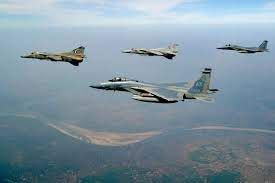
Why in News?
Indian Air Force will soon kick off Cope India’ exercise with the US Air Force (USAF) at the Kalaikunda airbase in West Bengal.
About Exercise Cope India:
- It is a bilateral joint exercise between Indian Air Force (IAF) and the United States Air Force (USAF).
- Cope India began in 2004 as a fighter training exercise.
- The exercise has evolved to incorporate subject matter expert exchanges, air mobility training, airdrop training and large-force exercises, in addition to fighter-training exercises.
- The exercise will further enhance operational capability and interoperability between the two air forces..
- The last edition of the exercise was held in 2019.
Source: The Hindu
ISRO’s Reusable Launch Vehicle Mission RLV LEX
Why in News?
What is a Reusable Launch Vehicle (RLV)?The Indian Space Research Organisation (ISRO) conducted a successful autonomous landing mission experiment for a Reusable Launch Vehicle (RLV) at the Aeronautical Test Range in Chitradurga, Karnataka.
- RLV is a type of spacecraft that is designed to be reused multiple times for launching payloads into space, instead of being discarded after a single launch like traditional rockets.
- They are seen as a more cost-effective and sustainable option for space launches, as they reduce the need for manufacturing new rockets for each mission.
- They typically consist of a reusable orbiter, similar to a space shuttle, and a reusable booster that provides the initial thrust needed to lift the orbiter and payload into space.
- After the payload is released into orbit, the orbiter and booster return to Earth and land back on a runway, where they can be refurbished and reused for future launches.
Developing RLVs requires advanced technologies, including-
- Heat-resistant materials for protecting the spacecraft during re-entry into Earth’s atmosphere
- Advanced guidance and control systems for landing and
- Reliable propulsion systems for launching and landing
- ISRO is developing essential technologies for a fully reusable launch vehicle to enable low-cost access to space.
- The RLV-TD is being used to develop technologies like hypersonic flight (HEX), autonomous landing (LEX), return flight experiment (REX), powered cruise flight, and Scramjet Propulsion Experiment (SPEX).
- It looks like an aircraft and consists of a fuselage, a nose cap, double delta wings, and twin vertical tails.
- First RLV experiment:
- In 2016, the RLV-TD was launched into space on a rocket powered by a conventional solid booster (HS9) engine.
- The spacecraft travelled at a speed of Mach 5 when re-entering the earth’s orbit and travelled a distance of 450 km before splashdown in the Bay of Bengal.
- Critical technologies such as autonomous navigation, guidance and control, reusable thermal protection system, and re-entry mission management were successfully validated.
- Second RLV experiment:
- The RLV LEX test on April 2, 2023, involved a Chinook Helicopter lifting the RLV LEX to a height of 4.5 km and releasing the RLV.
- After midair release, the RLV carried out an autonomous landing on the Aeronautical Test Range airstrip, under the exact conditions of a Space Re-entry vehicle’s landing.
- It achieved landing parameters as might be experienced by an orbital re-entry space vehicle in its return path.
- Reusable launch vehicles are considered a low-cost, reliable, and on-demand mode of accessing space.
- The cost of a launch can be reduced by nearly 80 percent of the present cost by using RLVs.
- NASA space shuttles have been carrying out dozens of human space flight missions.
- The private space launch services provider SpaceX demonstrated partially reusable launch systems with its Falcon 9 and Falcon Heavy rockets since 2017.
- SpaceX is also working on a fully reusable launch vehicle system called Starship.
- Several private launch service providers and government space agencies are working on developing reusable launch systems.
- RLVs have the potential to significantly reduce the cost of space launches, as a significant portion of the cost of traditional rockets comes from the need to manufacture new rockets for each mission.
- By reusing spacecraft, the cost per launch can be significantly reduced.
- Additionally, RLVs can provide greater flexibility and reliability for space launches, as they can be launched on-demand instead of needing to be manufactured and assembled for each mission.
Source: Indian Express
Fernarium at Eravikulam National Park
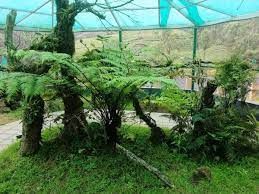
Why in News?
What are Ferns?Eravikulam National Park, located in Munnar, India, is known for its natural habitat of Nilgiri Tahr, and has recently introduced a new attraction – a Fernarium.
- Ferns are a type of vascular plant that reproduces via spores, rather than seeds.
- They have distinctive leaves, called fronds, which are often intricately divided into smaller leaflets.
- Ferns can grow in a wide variety of environments, from rainforests to deserts, and they play an important role in many ecosystems as a habitat for animals, as well as by providing food and shelter for a variety of other plants.
- Ferns are ecological indicators of healthy forests, and the climatic conditions inside the park are suitable for growing ferns.
- Ferns are part of the Epiphytic family and grow naturally in soilless conditions.
- They obtain water and nutrients through leaching from trees, and a large number of ferns are found on trees inside the park.
- The Fernarium is a collection of ferns and it is the first of its kind in Munnar.
- Currently, 52 varieties of ferns have been planted, and the plan is to cover all 104 varieties that are found in the park.
- This initiative aims to provide visitors with awareness about the biodiversity of the park.
| Location | Perched 7000 ft. above sea level, the Park was a former hunting preserve of British planters |
| Designation | Declared a Sanctuary in 1975, and a National Park in 1978 |
| Significance | Protects the highly endangered mountain goat, Nilgiri Tahr, and is the land of the Neelakurinji flower that blooms once in twelve years |
| Extent | Covers an area of 97 sq. km of rolling grasslands and high-level sholas |
| Climate | Receives heavy showers during the southwest (June/July) and retreating (October/November) Monsoons; one of the wettest areas in the world |
| Topography | Undulating terrain with grass, hillocks, and sholas; highest peak south of the Himalayas, the Anamudi, is located here |
| Vegetation | Majorly covered with rolling grasslands, with several patches of shola forests; important flora includes Actinodaphne bourdilloni, Microtropis ramiflora, Strobilanthus Kunthianus (Neela Kurinji), etc. |
| Wildlife Population | 29 species of mammals, including the endemic Nilgiri Tahr, Gaur, Sloth Bear, Nilgiri Langur, Tiger, Leopard, Giant Squirrel, and wild dog; 140 species of birds, including 10 unique to the Western Ghats; more than 100 varieties of butterflies and 20 species of amphibians are also recorded here. |
Source: The Hindu
|
38 videos|5283 docs|1116 tests
|
FAQs on UPSC Daily Current Affairs- 4th April 2023 - Current Affairs & Hindu Analysis: Daily, Weekly & Monthly
| 1. What is the significance of GS-I, GS-II, and GS-III in UPSC exams? |  |
| 2. How can I prepare for the GS-I paper in UPSC exams? |  |
| 3. What are the key areas covered in the GS-II paper of UPSC exams? |  |
| 4. How can I prepare for the GS-II paper in UPSC exams? |  |
| 5. What are the key areas covered in the GS-III paper of UPSC exams? |  |


